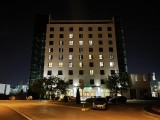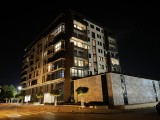Apple iPhone 13 review

Dual camera, sensor-shift stabilization
The Apple iPhone 13 offers a similar camera setup to the iPhone 12's. There are two 12MP cameras on the back and one 12MP selfie shooter at the front. The SL 3D scanner for Face ID assists the Portrait mode in selfies.

There are two hardware upgrades and a couple of software ones available for the iPhone 13.
The primary 12MP camera has gotten a new sensor with larger pixels and high-end sensor-shift stabilization. It now uses a larger Sony sensor with 1.7µm pixels (vs. 1.4µm on the iPhone 12). The lens is 26mm f/1.6, like on the iPhone 12's main camera, but the stabilization is of a different kind. Instead of optical stabilization, this camera now uses the iPhone 12 Pro Max's sensor-shift stabilization. This means the sensor itself is stabilized in real-time and not the lens akin to the in-body stabilization or IBIS seen on many large-sensor digital cameras.
The secondary camera is identical to the iPhone 12's - a 12MP imager with 1.0µm pixels and 14mm f/2.4 lens for ultrawide photos. The focus is fixed, and there is no stabilization.
The selfie camera is also lifted straight from the iPhone 12. It has a 12MP sensor with 1.0µm pixels and a 23mm f/2.2 lens. The focus is once again fixed. When using portrait mode on this camera, it captures depth info with the structured-light 3D scanner, so it should be taking some impressive selfies portraits.

All three snappers support up to 4K@60fps video capturing with Cinematic Stabilization and Expanded Dynamic Range. Dolby Vision HDR capturing is possible on all cameras in all modes. The new Cinematic Mode works on the primary and selfie shooters only.
Camera app and features
The viewfinder has been mostly the same since the iOS 13 and the iPhone 11 - you can see outside of the viewfinder thanks to the precise calibration of the two cameras that allows seeing what will be left outside of the frame in real-time.
The Apple image processing includes all legacy features like Smart HDR, Night Mode on all cameras, and Deep Fusion.
The Night Mode icon pops up automatically when a low-light scene presents itself, and it will take a pseudo-long-exposure shot, handheld, of course. You will see the seconds suggested next to the Night Mode icon, but if you tap on it, you can change the simulated long exposure or altogether disable it. Usually, it's between 1 and 2 seconds, but sometimes the phone allows you to go for up to 30 seconds depending on the environmental light or its lack thereof. You can use this mode on the main, the ultrawide, and even the selfie snapper.

Deep Fusion is used when light conditions aren't ideal, say, indoors. It triggers instead of Smart HDR and Night Mode. Deep Fusion uses four frames before you hit the shutter, four more once you do, and one long exposure shot. The Neural engine will select the best frames and create a high-quality HDR photo that is very detailed, sharp, and more natural-looking. The Neural processor's machine learning process analyzes the image being taken and processes them differently depending on what's in the frame - say, sky, foliage, or skin tones. Meanwhile, structure and color tones are based on ratios obtained by the Neural unit on the A15 CPU.
As usual, all cameras talk to each other, so they already know the correct exposure and tone mapping settings when you switch between them. This applies to both stills and videos.
The camera interface is mostly unchanged. You swipe between modes and have a couple of settings you can uncover with an upward swipe - flash, night mode, live photo, photo aspect, exposure compensation, and filters. In video mode, you can change the resolution and frame rate from the viewfinder.






Camera app • Ultrawide • Night Mode • Photographic styles
Portrait mode is available on the main and the selfie cameras. There is no RAW mode on the iPhone 13.
There is a new feature called Photographic Styles which automatically edits a photo, one element at a time (applying different corrections to the subject and background, for example). You can choose between Standard, Rich Contrast, Vibrant, Warm, and Cool. You can tune each of these modes by your liking, and set your preferred one as default. It's like filters, but more permanent.
The new hardware and software on the iPhone 13 generation enabled another interesting camera features - Cinematic Mode. It does automatic rack focus, but the phone records a depth map alongside the video, so you can change the focus point manually after the fact. Editing such videos is possible in iMovie and Clips apps.
Photo quality
The 12MP photos from the main camera are rich in detail, with great contrast and incredibly low noise levels. The dynamic range is okay, not the best we've seen, but we can describe it as balanced and natural instead of over-the-top.
The white balance is exceptional, and the colors are as true to life as possible. Some of the less-colorful samples may seem, well, a bit anemic, but we've looked, and these were the real colors. If you are not keen on Apple's way of using painfully accurate colors, you can always opt for one of the Photographic styles and set the tone and hues for every photo that comes next.
One thing we are not fans of is the foliage presentation. Sometimes the grass is good and leaves look fine, other times - they are awfully smeared. With this new and even bigger sensor, we sure expected richer intricate detail, but we got the same as last year and the year before that. It seems Apple's skills are not particularly good in this area.
The 12MP ultrawide photos are some of the widest we've shot so far and look great on the screen and when shared on social networks. The resolved detail is alright, the contrast is great, and the colors - accurate.
The dynamic range is identical to the main camera's - balanced and not that wide.
The foliage here looks even worse due to the smaller pixels and less detail to work with - the grass and trees are looking like oil-painting at times.
The main camera can do portraits, and it can do them very well. The subjects are outstanding - sharp and detailed, colorful, noise-free, while the photo has nicely balanced exposure. The background blur is enjoyable.
The subject separation is proficient, though there are times where some objects from the background may get in the way of their accuracy.
Still, the AI behind this portrait mode and the depth map is very capable, and we know many users will be using it and showing off their cool photos.
Night Mode triggers automatically when the light is low. You can opt-out of using it or correct the suggested exposure time, but we strongly suggest leaving it to do its job as it sees fit. The mode usually opts for 1s or 2s exposure times, and the photo is saved instantly, making it among the fastest Night Modes on the market.
The Night Mode-enhanced photos are brilliant - they are incredibly detailed, with excellent color saturation, great contrast, commendable exposure, and good dynamic range. The noise reduction is proficient and cleans the photos very well without taking much detail in the process.
These photos look well balanced - they are not too bright and were kept as natural-looking as possible.








Main cam Auto Night Mode, 12MP
If you opt-out of the Night Mode, you'll get a little bit softer photos with somewhat washed-out colors, but they are still detailed, with good contrast and dynamic range. And exposure is pretty good, too, for a non-Night Mode image. In fact, this is just how the scenes look to our eyes, so kudos for the life-like look.
Just like on the iPhone 12, the iPhone 13 shoots acceptable ultrawide photos by always using the Night Mode (usually 2-3s). The images offer balanced exposure and good-looking color saturation; the contrast is good, too.
The photos are quite soft and noisy, but plenty usable for looking at the phone's screen or sharing them across various social networks.
We do not recommend disabling the Night Mode on the ultrawide camera. The images taken without it are rather poor - they are dark, most of the detail is smeared, they are overrun with noise, and the colors are often desaturated.
And here are photos of our usual posters taken with the Apple iPhone 13. Here's how it stacks up against the competition. Feel free to browse around and pit it against other phones from our extensive database.



Apple iPhone 13 against the Samsung Galaxy S21 5G and the Asus Zenfone 8 in our Photo compare tool
Selfies
Apple has been offering two Field-of-View modes on the selfie camera for a few generations already - the slightly zoomed-in 7MP crop, which is equivalent to a 30mm field of view, and the full 12MP mode, which has a 23mm equivalent FoV.
If you hold the iPhone in portrait orientation, selfies are cropped to 7MP to provide a tighter framing, but if you rotate the phone horizontally, you will get more of the scene with the camera app automatically switching to the wider 12MP mode. You can also switch between those two modes manually - there is a switch shortcut on the viewfinder.
The 12MP photos from the front camera are outstanding and one, if not the best, selfies we've seen to date. The resolved detail is spectacular, the contrast and the dynamic range are praise-worthy, and the colors are impressively accurate. The noise is low and handled very well even when shooting indoors - something few selfie cameras can do.
Indeed, these are some of the best selfies we've taken in quite a while.
You can shoot portraits with the front camera as the SL 3D snapper is assisting with a depth map. That's why the subject separation is astounding, and the background blur is thoroughly impressive. Just like the regular selfies, the portrait ones excel in everything - detail and sharpness, colors, contrast, balanced dynamic range.
By the way, the portraits are shot in 7MP, meaning the camera crops a part of its available FoV and shows a zoomed-in shot.
Shootout with the iPhone 12
We couldn't miss the opportunity to pit the new iPhone against the old one, and the photos are in.
It's hardly a surprise that the primary cameras of the iPhone 12 and iPhone 13 shoot identical photos. Even if there is a new sensor with a different type of stabilization on the iPhone 13, it is impossible to tell apart the photos from the two phones.
The iPhone 13 and iPhone 12 use the same 12MP camera with the same 14mm f/2.4 lens for ultrawide-angle photos. The processing hasn't changed on the new iPhone 13, and that's why we have another batch of identical photos.
We hope you didn't expect to see differences in the processed Night Mode photos. Despite the new sensor on the iPhone 13, the photos we took at night using Auto Night Mode (the default setting) are indistinguishable.
We thought we'd see some minor differences on the photos shot without Night Mode, but that did not happen either. The unprocessed photos are equally good, with similar exposure, dynamic range, resolved detail and noise control.
And since the ultrawide cameras are identical in both hardware and software, we saw no point of showing you yet another batch of the same photos.
Conclusion: Apple iPhone 13 offers the same photo quality as the iPhone 12, pixel to pixel.
Video quality
The iPhone 13 captures videos up to 4K at 60fps with all three cameras, and it can even do it simultaneously if you have the right app.
All videos are digitally (also optically where available) stabilized - Apple calls this cinematic video stabilization. All modes, including the 4K@60fps as well, feature expanded dynamic range thanks to the Smart HDR. The slow-mo options max out at 1080p at 240fps.
You can also capture HDR videos straight into the Dolby Vision format with up to 4K at 60fps (the iPhone 12 was limited to 30fps). You can edit these videos on the go on your phone, you can upload them on YouTube or any other popular platform, or even send them to your friends. The Dolby Vision information is saved outside of the video stream, so the video will look normal to any non-HDR player/screen and will be color-boosted on any Dolby Vision-compatible player and display.
You also have a choice between H.265 HEVC and H.264 video encoders. The High Efficiency mode uses H.265 and is mandatory for 4K@60fps and HDR footage, while the More Compatible mode (H.264) provides easier playback across different devices.
The iPhone 13, just like the previous iPhones, captures wide stereo audio for the videos at about 192kbps. This is spatial sound, and it's richer and deeper compared to just regular stereo.
The 4K video quality from the main camera is spectacular. The detail is excellent, the picture is with natural sharpness, the dynamic range is exceptional, the contrast is great, the color presentation is with perfect accuracy. These 4K videos have to be among the best we've seen, with excellent footage and sound. The stabilization works amazing, too!
The 4K videos from the ultrawide camera are equally brilliant. They excel in everything and have to be one of the most detailed ones we've seen, as far as ultrawide cameras go.
We also shot low-light clips on the iPhone 13. The one from the main camera is great - it has enough detail, lovely color saturation, great contrast and stays true to life. The dynamic range isn't bad, too, given we shot quite late at night. The noise reduction is a bit aggressive and takes some fine detail with it, but this is a minor issue, really.
The video from the ultrawide camera is more than usable. It is darker as this camera has an f/2.4 lens, but if for some reason you decide on using the UW camera at night, it will capture a decent video with good detail and acceptable noise and colors. We'd say we've seen a lot worse, and the best description for this clip is that it is the least bad video we've captured on a UW camera for quite a while.
We've also shot some footage with the most notable new camera feature - the Cinematic mode. It simulates rack focus automatically and is shot in 1080p resolution with 30fps. This mode is available on the main and selfie cameras. But how this works?
Well, this is an advanced Portrait mode with blur simulation for everything that should be out of focus. It works exactly like portrait mode - the depth map is created in real time and an algorithm automatically decides which subject should be on focus. The automatic blur works side by side with the autofocus and the overall results are, well, let's say good.
The videos are with very good quality and if you know what you are doing and doesn't mind some post processing, you can make pretty awesome clips.
The depth map is captured outside the clip, and you can easily edit these clips in iMovie or Clips. You can change the aperture, the subject that gets the focus, and more. So, if the Auto mode doesn't get it right, nothing is lost - since it's all done by software, you can fix everything later.
Finally, here is the Apple iPhone 13 in our video comparison database.



2160p: Apple iPhone 13 against the Samsung Galaxy S21 5G and the Asus Zenfone 8 in our Video compare tool
Reader comments
- Mohammed kh
- 04 Apr 2025
- 64M
is the phone new or used ? is the phone work in Middle East and Africa ?
- Anonymous
- 22 Mar 2025
- XBB
Does ios support airdrop apps, telegram airdrops and misses browser?
- Anonymous
- 17 Mar 2025
- Cb8
Yes

























































































